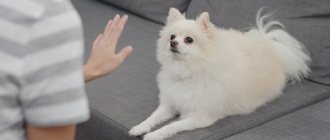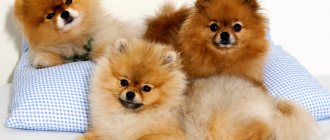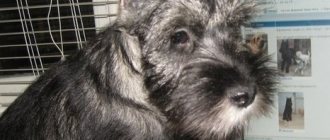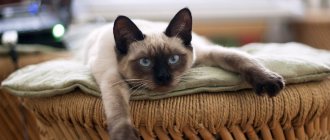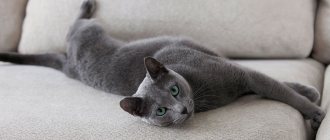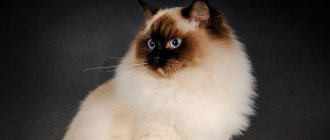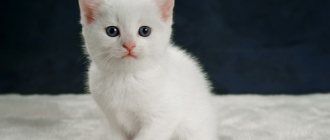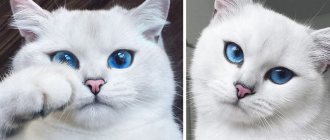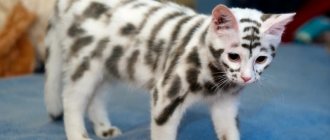Combination black And white on a cat's fur coat is found in both outbred and purebred cats. This color called black bicolor, and color combinations are different.
For the first time, a black and white cat was presented at the world felinological exhibition in 1969, where several individuals officially performed, and previously this coat color was considered a defect. Since then, bicolors have become popular and are found in most cat breeds .
Features of black and white color
Cats with contrasting colors are not very rare and are widespread throughout the globe. Despite its apparent simplicity, the combination of white and black has several important features:
- Uniqueness. This coloring is purely individual, so it is almost impossible to find two black and white cats with identically located spots and stains.
- Spread of color to the paws. A black and white cat may have two-color pads. Their skin is partly dark and partly pink.
- Unusual eyes. Many black and white cats have green tinted irises. Also among them are individuals with heterochromia.
- Dominance of one of the colors. Black and white cats cannot have a uniform color - one color will definitely predominate.
Interesting! In the USA, the black and white color is called “tuxedo”. Americans probably associate it with a classic men's suit, worn with a light shirt. Initially, the phrase “tuxedo color” meant an almost entirely black cat with a white mustache, “slippers” and chest.
Selkirk rex
Nicknames: cat-toy, little bear and cloud are very suitable for Selkirks. These are muscular cats with strong bones, thick short (or semi-long) fur, arranged in picturesque curls. Like their ancestors - the British, Persians and exotics, the Selkirks are calm and good-natured. Selkirk curls are a manifestation of another rex mutation discovered in a mongrel kitten in one of the cat shelters in the USA in the 80s of the last century. The kitten attracted the attention of an experienced breeder, and she decided to breed a new breed. As with the Cornish, the quality of the curls is more important, which is why the Selkirk standards allow all colors.
Varieties of color
Although all black and white cats appear identical, this is absolutely not the case. There are 3 main varieties of this color:
- van;
- harlequin;
- bicolor
Wang
With this color, the body of a black and white cat is covered with light hair with several small charcoal marks on the head, muzzle and near the tail of the animal.
Harlequin
Black and white cats with this coloration have light fur with numerous large dark markings. The charcoal pattern can combine stripes, small patterns and large areas of dark fur. The main thing is that the black spot is uniformly colored and does not have white hairs.
Bicolor
The body of an animal with this coloring is covered with blue-black fur with snow-white spots of different shapes and sizes. In the classic version, a bicolor cat has a “tie” in the chest area, as well as light markings on the sides, face and head.
Color ratio
According to another, more detailed classification, black and white (b/w) color is divided into several types:
- coal-black background without clear light areas with unevenly interspersed white hairs;
- with a charcoal background and small white areas in the neck, chest or lower limbs;
- with a large, clearly defined white patch of fur on the cat's throat;
- with a mark that flows from the chin to the neck of the animal;
- with a uniform light area that starts from the chin and covers the chest, abdomen and all four limbs;
- with white bottom and sides, as well as large black markings on the back, back of the head and tail of the cat;
- with a charcoal tail and small black spots on the back;
- residual black - with several small dark markings on head and tail;
- dominant white - black pigment is present exclusively at the gene level.
Breeding Features
Getting black and white kittens with the “correct” colors in any breed is very difficult. The difficulties are caused by the fact that in the bicolor color the spots must have beautiful clear outlines and not merge with each other, and the back is darkly pigmented. In addition, black and white cats with symmetrical markings are of particular value. But due to the fact that the localization of spots cannot be predicted in advance, such animals are born very rarely and are more expensive than others.
Black and white kittens arise from the mating of two-colored individuals or a bicolor cat and a cat with a tortoiseshell coat color. Moreover, the shade of the offspring’s fur coat depends on the combination of genes of the parents.
Cornish Rex
An elegant and energetic cat of medium size, on high legs, with a wedge-shaped muzzle and huge ears. The calling card of the Cornish is its short, curly fur, which runs across the body in spectacular waves. All representatives of the breed are descendants of one outbred cat, born on a farm in Cornwall (Great Britain) in the middle of the last century. The owner of the farm was breeding Rex rabbits, and for some reason this word became part of the name of the new cat breed. And now it is part of the names of all curly-haired breeds. The “quality” of wool waves is much more important than the color of the coat, so the standards allow all existing colors.
Breeds of black and white cats
For a long time, the black and white color remained unrecognized by felinological systems, and purebred cats with a similar color were mercilessly discarded. The situation changed in 1969, when animals with such coats first appeared at the exhibition. Now black and white cats are found in many breeds.
British
For a long period, only blue or smoky colors were cultivated in the breed. But with the popularization of the British, their color range expanded significantly.
In addition to the standard types - van, harlequin and bicolor - among the black and white cats of this breed there are individuals with the unrecognized mitted color. It requires the presence of a light stripe between the chin and groin.
Also, black and white cats of the British breed with a mitted color should have light “socks” or “socks” on their paws.
Oriental
The standard of this breed provides for more than 200 colors, including all black and white variants. Moreover, a van, bicolor and harlequin kitten can be born in one litter. There are many varieties of black and white cats in the breed.
Among the Orientals there are also charcoal individuals with light paws and markings on the face, and snow-white animals with small contrasting spots.
Canadian Sphynx
Bicolor cats are often found among cats of this breed. Moreover, a contrasting pigment colors the skin. Black and white cats of this breed often have a charcoal tail and at least one ear. Sphynx cats are also allowed a symmetrical dark marking on the top of their head.
Kurilian and Japanese bobtails
These tailless cats also have a black and white color, which is characterized by certain features. Bicolors must have a closed white collar on the neck and a light marking on the muzzle in the shape of an inverted V.
Harlequins should have charcoal spots on the forelegs, back and head. Black and white van bobtails have a dark tail and a completely light back.
Kurilian Bobtail
Japanese Bobtail
Maine Coon
These large cats can be black and white in color. Moreover, they are more characterized by the bicolor type, in which most of the body, including the muzzle and ears, is covered in charcoal color.
Among the black and white Maine Coon cats, there are almost no individuals with the “van” and “harlequin” colors, so the cost of such animals can reach several hundred thousand rubles.
Persian
The most common color found in black and white Persian cats is the “harlequin” color, in which 5/6 of the body surface is lightly pigmented. The rest of the body is covered in a rich, cool charcoal color.
For the Persian cat breed, dark whiskers and white hairs on black spots are unacceptable.
Siberian
In addition to the usual variegated colors, the breed allows more than a dozen different colors, including a black and white version. Moreover, a fluffy Siberian can have all three types with clearly defined spots that do not overlap with each other.
The eyes of a black and white cat of this breed are pigmented yellow or green.
Turkish Angora
Although many believe that the Angora is a pure white cat, it also has other color variations. The bicolor breed has light legs, chest, collar, muzzle and belly, as well as a white mark on the forehead that looks like an inverted V.
Manx and Cymric
Tailless cats have many color options, including black and white.
Manx
Cymric
Munchkin
These cute, short-legged cats can have black and white fur. Bicolor munchkins often have light markings on their faces, “socks” on their paws, a “collar” on their necks, and a “tie” on their chests.
Cornish Rex
This figurine-like curly cat also comes in black and white. Moreover, in addition to the three main color options, the breed allows the “tuxedo” color, in which the Cornish’s chest, paws and belly are light, and the top of the head, back, shoulders and sides are charcoal.
The iris of a Rex black and white cat can be blue, yellow, olive or copper.
Turkish van
From the name of the breed it is easy to guess which type of coloring is inherent in these cats. Black and white Turkish Vans have a light body with small dark markings on the head and a charcoal tail.
The main differences between purebred pets and domestic ones
Scientists have proven that domestic cats have a common ancestor - the steppe cat, which still lives in North Africa . About 200 cat breeds have been registered by felinological organizations. All of them are the result of painstaking work of breeders and have clear standards. The shape of the head, muzzle, eyes, ears, length of fur, limbs, tail, body, color and character are taken into account.
Pedigree cats have documents that confirm their belonging to the breed . They record the names of its three generations and color features. The meaning of an animal's thoroughbred is that when purchasing, the owner will know exactly what character the animal has, what health nuances need to be paid attention to, and how to care for it.
For example , the Siamese cat is known for its loud meowing and vindictiveness, based on this, the future owner knows what he will have to face. Sphynx cats require special skin care and nutritional control due to their excessive appetite.
There are mixed breeds of cats with a whole bunch of genetic pathologies, but at the same time they have an attractive appearance and an easy-going disposition. All this must be taken into account when choosing a kitten - the necessary information can be obtained from the owner of the nursery. This is why experts advise contacting specialized nurseries so as not to literally buy a “pig in a poke.”
If you come across a baby not from a nursery, but, say, it was given to you as a gift, or you picked it up on the street, you can try to determine the breed yourself. To find out what breed a cat is, you need to carefully examine the animal, determine its striking features , and then study the appropriate breed standard.
You can go the simple route and contact a specialist who will tell you how to recognize a cat’s breed and point out its distinctive features. But most often on the streets there are outbred cats that only vaguely resemble their purebred relatives . Such animals often have an elongated muzzle and body, a thin build, medium-length gray, brown, black or tricolor hair, muscular paws with long claws, round eyes, and an energetic tail that expresses the entire range of emotions of the animal. Yard murkas do not exceed 50-75 cm in length and weigh between 2-6 kg.
In fact, purebred aristocrats are not much different from barn cats, so determining the breed by eye often causes difficulties. Most look closely at the external characteristics and compare them using pictures on the Internet.
However, professionals assure that appearance is not the most compelling argument in favor of an animal’s thoroughbred . The cat's habits, character, and temperament are important here. It takes a long time for outdoor cats to get used to the litter box and they don’t realize that they shouldn’t tear up the sofa or nibble on the flowers on the windowsill. Owners have to put a lot of effort into raising their pet and instilling good manners in it. Pedigree cats are another matter! They have the habits of an intellectual at the genetic level.
Character and temperament
It is generally accepted that the character and temperament of representatives of the cat family is influenced not only by the breed, but also by color. Any cat with a black and white coat is endowed with an ideal disposition. She is resistant to stressful situations, sociable, intelligent and assertive.
A black and white cat subtly senses the change in its owner’s mood and will not demand attention at the wrong time. She does not harbor evil and will not take revenge for insults.
Black and white cats are very impressive animals with an attractive appearance and wonderful character. They look much more advantageous than their monochromatic counterparts and have noble habits.
